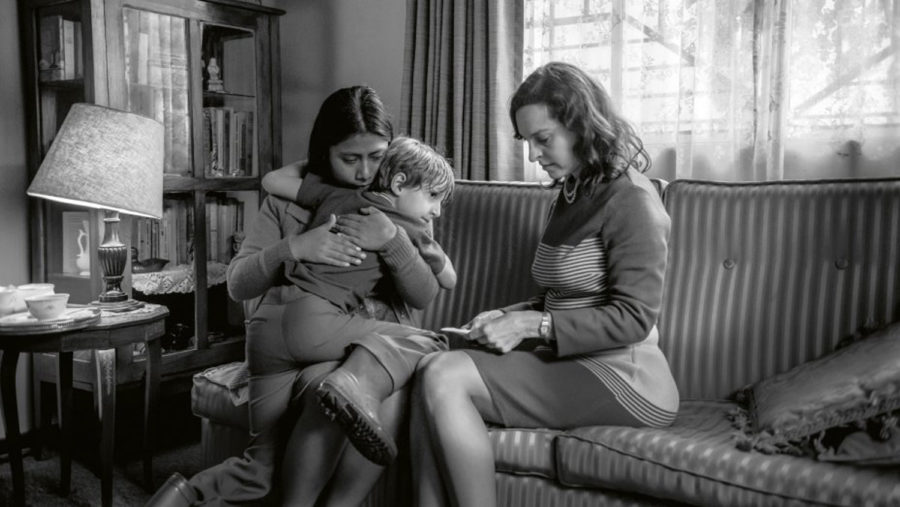Golden Globe-winning film ‘Roma’ hits home for Alfonso Cuaron
Alfonso Cuaron has directed “Y Tu Mamá También,” “Harry Potter and the Prisoner of Azkaban” and “Children of Men” before his work on “Roma.”
January 10, 2019
Soaked and gasping for breath on the ocean shore, a housemaid is squeezed tightly by four children and their mother — her employer — who comfort her as she cries, telling her over and over they love her and she is a part of their family.
This image appears on the cover for the film “Roma,” which has won a number of awards this year, including the 2018 Golden Globe for Best Foreign Language Film. It also received the Golden Lion at the 2018 Venice International Film Festival and the National Society of Film Critics award.
The film’s director, Alfonso Cuaron, is no stranger to winning awards. Cuaron is the first Latino and Mexican director to win the Academy Award for Best Director for his 2014 film “Gravity,” as well as the 2018 Golden Globe for Best Director for “Roma.” He is also known for directing the films “Y Tu Mama Tambien,” “Harry Potter and the Prisoner of Azkaban” and “Children of Men.”
“Roma,” his latest work, is a black-and-white art film, shot with a 65mm camera with ultra-high definition and crisply elaborate sounds that can best be heard in theaters. While “Roma” debuted on Netflix in November, it was also the first Netflix film to be granted theatrical screenings. This was a big step for Netflix in its support for foreign films and non-American filmmakers, embracing its global audience and promoting diversity. The cast of “Roma” was made up of nonprofessional and first-time actors, including Yalitza Aparicio, the starring actress who delivered a deeply emotional performance.
Cuaron made “Roma” as a tribute to his own childhood nanny Liboria “Libo” Rodriguez, with a narrative based on his childhood experiences growing up in the neighborhood of Roma in Mexico City. The story is told through the eyes of Cleo (Yalitza Aparicio), a housemaid working for a middle-class family in the Roma neighborhood in the 1970s.
The film addresses issues of economic inequality, gender roles and toxic masculinity through the lens of the housemaid and her relationships with the family. Cuaron beautifully illustrates the complexity of Cleo’s relationship with the family she serves. In many ways, she is more of a mother to the children than her employer Sofia (Marina de Tavira). It is Cleo who sings to the children in her indigenous language, Mixteco, to put them to sleep and gently wakes them up in the morning.
Cleo is both a member of the family but also an outsider. While the family loves her, she is never quite seen as one of them. Although she is taken to see the family’s doctor and accompanies them on a New Year’s Eve trip to an hacienda, she does not join the family at the table for meals and is responsible for watching and even rescuing the children when necessary.
Cleo’s life extends beyond her daily work and Cuaron depicts Cleo as a multifaceted character, showing her personal world with its own obstacles. Housekeepers and maids like Cleo are often silenced in films, problematically portrayed as meek, quiet types who are characterized through the lens of their employers. Cuaron takes a fresh approach in “Roma,” making Cleo an active character and giving a spotlight to female domestic workers who are otherwise invisible in films.
Cleo must balance tending to the needs of the children with her own pregnancy and personal hardships, as Sofia takes out the troubles of her marriage on the children and Cleo. The film often explores the parallels between the two women. Despite their economic differences, they both have been wronged by men and experience the isolation and abandonment that comes with living independently.
“No matter what they tell you, we women are always alone,” a drunk and distraught Sofía warns Cleo after haphazardly parking and almost crashing the family car.
The majority of the scenes are shot from afar, with wide moving shots and long takes that manage to replicate Cuaron’s childhood home and create an effect as if the viewers are looking in. While there are detailed close-ups of puddles on the ground and Cleo’s hands washing dishes and cleaning up dog poop, there are rarely any close-ups of the characters’ faces.
Cuaron does not glorify servitude in “Roma.” He shows the realities of inequality in Mexico and the class hierarchies that separate employers from employees, despite living together. The film includes subtitles for Mexican Spanish as well as Mixteco, which are bracketed, another way of giving voice to indigenous women who are otherwise silenced.
Cuaron manages to recreate his childhood experiences in the neighborhood where he was raised, showcasing through Cleo the hard yet important roles of housemaids in children’s upbringings. In the film’s cover scene, when the family envelopes Cleo with their hugs, it becomes apparent that Cleo truly is an integral part of the family who has helped bring them stability.








